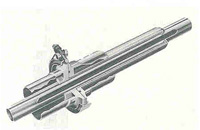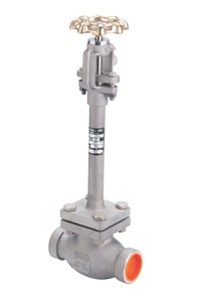Liquid Piping System Components
The considerations described for Compressed Gas Piping System Components are applicable to liquid piping systems. This section discusses additional considerations for liquid systems.
For information on low-temperature concerns or material selection for cryogenic liquid hydrogen piping components, please see Material Compatibility.
Apparent good seals made at ambient temperatures can readily fail after a single thermal cycle.
Detailed component and system design information can be found in CGA H-3, Standards for Cryogenic Hydrogen Storage.
Bayonet joint for vacuum-jacketed transfer lines (CVI Corp., Columbus, Ohio)
Some specific considerations for liquid piping system components are:
Bayonet joint for vacuum-jacketed transfer lines (CVI Corp., Columbus, Ohio).
- Bellows expansion joints are used in the outer jacket of vacuum jacketed pipe spools. The expansion joints should not be extended or compressed during installation to make up for deficiencies in length, nor to compensate for improper alignment.
- Bayonet-design couplings should be used for demountable joints.
- Mechanical joints such as threaded and compression fitting should NOT be used. Joints made leak free at ambient temperatures can fail after a single thermal cycle.
Because of the low-temperature contraction of the nonmetallic seals in valves, extended bonnet valves are used so that the valve stem seals will remain relatively warm.
When warmed, hydrogen liquid trapped in a closed space will generate very high pressures. Therefore, valves should not trap liquid when they are closed. Because of this, globe valves are the most popular choice.
Goddard 231 series globe valve
When ball valves are used, they should be modified in such a way that liquid is not trapped when the valve is closed. One such modification is drilling a hole in the ball. Ball valves modified in this way must be installed in such a way that the hole faces the high-pressure side of the valve when the valve is closed.
Pneumatic operators are usually chosen for remotely operated valves so that potential ignition sources are remote from the valve. If electrical actuators are used for valves, they must be properly classified for use in a hydrogen environment.
References
ANSI/AIAA G-095, Guide to Safety of Hydrogen and Hydrogen Systems
CGA H-3, Standard for Cryogenic Hydrogen Storage
R.F. Barron, Cryogenics Systems, 2nd ed. Oxford University Press, New York, 1985, pg. 411.
F.J. Edeskuty and W.F. Stewart, Safety in the Handling of Cryogenic Fluids, Plenum Press, New York, 1996, pg. 102.



